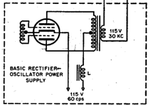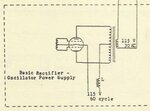neazoi
Advanced Member level 6

Hello, for a project of mine I need a way to generate a power SIN signal of somewhere between 30-40KHz (does not need to be variable. I emphasize power, the signal will be used to control other stuff, so a 555 or a chip generator is useless.
As an indication compare it with the output of a several watts 50Hz transformer, just to indicate what short of power needed (exactly not known)
Is there any easy way to do it?
I was thinking something like a power sinewave RF oscillator in the 30-40KHz range
I have found a suitable schematic using a tube, attached, I think it uses a dual anode triode (dual triode)?
As an indication compare it with the output of a several watts 50Hz transformer, just to indicate what short of power needed (exactly not known)
Is there any easy way to do it?
I was thinking something like a power sinewave RF oscillator in the 30-40KHz range
I have found a suitable schematic using a tube, attached, I think it uses a dual anode triode (dual triode)?
Attachments
Last edited:



